The Tivoli Theatre is a former theatre in Brisbane. It operated between 1914 until its closure in 1965 and demolition in 1969. It was situated opposite the Brisbane City Hall, in the site of the present King George Square.
Contents

The Tivoli Theatre is a former theatre in Brisbane. It operated between 1914 until its closure in 1965 and demolition in 1969. It was situated opposite the Brisbane City Hall, in the site of the present King George Square.

The Tivoli Theatre's construction began in Albert Street, Brisbane in 1914, on the site of the former Turkish baths. [1] It was designed by architect Henry E. White in an Art Nouveau style and could house 1800 people on three levels. It was chilled by an air plant that could pump ice-cold air through the venue. It had ruby red carpets. It also featured a garden rooftop theatre holding 1200 with open sides for ventilation and steel shutters which could keep out rain. [2] [3] Its facade overlooking Albert Square had Oriental influences. [1]
It opened on 15 May 1915 [4] and featured a production of the Tivoli Follies in the auditorium and a vaudeville production in the rooftop theatre. These were staged by Hugh D. McIntosh, showman and promoter who was influential in the Rickard Tivoli circuit of Australia. It had a rival in vaudeville theatre the Empire Theatre also located in Albert Street which drew bigger crowds. [5]
Smoking was permitted in the rooftop theatre. During Brisbane's hot summer months, the rooftop garden was meant to be more desirable. As the building had two entrances, it was possible for two production companies to co-exist on site with separate audiences as well. [1] Films were later shown in both venues after the advent of talking films.
Union Theatres Ltd. renovated the Tivoli Theatre in 1927 using Sydney architects Kaberry and Chard. This was to provide for more seating as the venue changed from a live theatre venue to that more suited to a film going audience. Two galleries were removed to make way for a single dress circle. [1] [6] With the onset of the Great Depression in the 1930s it was critical that the theatre could accommodate enough people to recover costs from cinema audiences as live theatre attendance dropped.[ citation needed ]
More renovations to the foyer and the auditorium took place in 1935.[ citation needed ]
The Tivoli was purchased by the Brisbane City Council in 1963 and closed in 1965. The intended King George Square development led to a number of buildings being demolished, including Centennial Hall and the Hibernian Building. [7]
Programs from the theatre are held in the Fryer Library of the University of Queensland.

The Empire Theatre is a heritage-listed theatre at 56 & 56A Neil Street, Toowoomba, Toowoomba Region, Queensland, Australia. It was added to the Queensland Heritage Register on 31 May 1994.
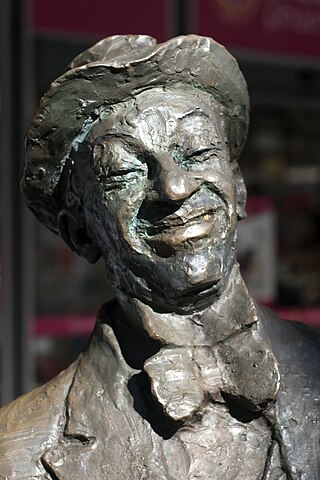
Roy Rene was an Australian comedian and vaudevillian. As the bawdy character Mo McCackie, Rene was one of the most well-known and successful Australian comedians of the early 20th century, and the local answer to Charlie Chaplin.
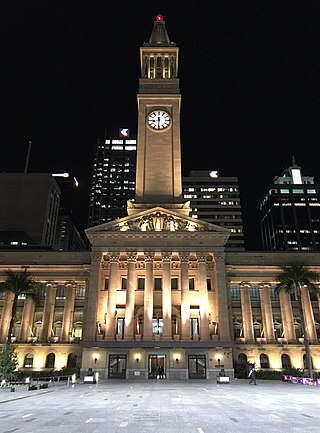
Brisbane City Hall, in Brisbane, Queensland, Australia, is the seat of the Brisbane City Council. It is located adjacent to King George Square, where the rectangular City Hall has its main entrance. The City Hall also has frontages and entrances in both Ann Street and Adelaide Street. The building design is based on a combination of the Roman Pantheon, and St Mark's Campanile in Venice and is considered one of Brisbane's finest buildings. It was listed on the Register of the National Estate in 1978 and on the Queensland Heritage Register in 1992. It is also iconic for its Westminster chimes which sound on the quarter-hour.

The Brisbane Powerhouse is a performing arts and cultural centre which is housed in a former power station in the Brisbane suburb of New Farm in Queensland, Australia. The venue offers an array of live performances, visual art displays, exhibitions, festivals, and free community events.

King George Square is a public square located between Adelaide Street and Ann Street in Brisbane, Queensland, Australia. Brisbane City Hall is adjacent to the square.
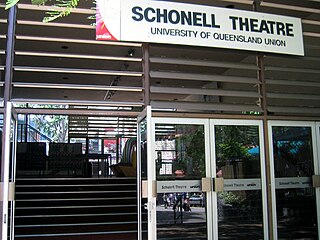
The Schonell Cinema & Live Theatre is a venue for theatre, special events and cinema screenings in Brisbane, Australia. It consists of Theatre One: a 420-seat, single auditorium theatre capable of hosting musical performances, plays and lectures and Cinema 2, a 175-seat cinema suitable for exclusive screenings, presentations and small performances.

Petrie Terrace is an inner suburb in the City of Brisbane, Queensland, Australia. In the 2021 census, Petrie Terrace had a population of 1,168 people.

An atmospheric theatre is a type of movie palace design which was popular in the late 1920s. Atmospheric theatres were designed and decorated to evoke the feeling of a particular time and place for patrons, through the use of projectors, architectural elements and ornamentation that evoked a sense of being outdoors. This was intended to make the patron a more active participant in the setting.
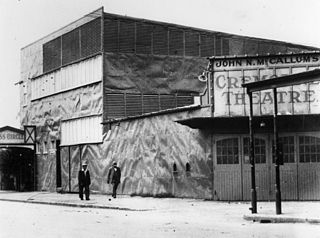
The Cremorne Theatre was a theatre in South Brisbane, Brisbane, Queensland, Australia that operated, with interruptions, from 1911 to 1954. Although nothing remains of it today, the general location retains its cultural significance from the first half of the twentieth century as a theatre precinct, thanks to the nearby construction of Queensland Performing Arts Centre (QPAC) in 1985. Its name lives on in the new Cremorne Theatre, one of the venues within QPAC.
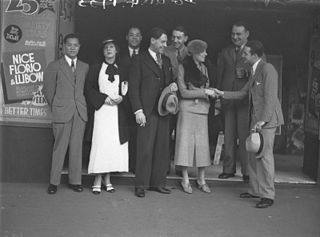
The New Tivoli Theatre, Sydney, previously known as the Adelphi Theatre and the Grand Opera House, was a theatre and music hall at 329, Castlereagh Street, Sydney, Australia, which was long at the heart of the Tivoli circuit.

Strand Theatre is a heritage-listed cinema at 159–167 Margaret Street, Toowoomba City, Toowoomba, Toowoomba Region, Queensland, Australia. It was designed by George Henry Male Addison and built from 1915 to 1933 by Luke Halley. It was added to the Queensland Heritage Register on 21 October 1992.
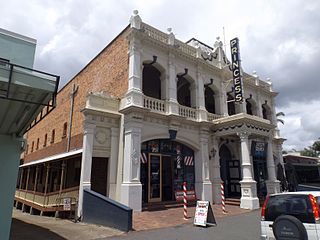
Princess Theatre is a heritage-listed theatre at 8 Annerley Road, Woolloongabba, Queensland, Australia. It was designed by architect John Beauchamp Nicholson and built in 1888. It is also known as South Brisbane Public Hall and Boggo Road Theatre. It was added to the Queensland Heritage Register on 21 October 1992.

La Boite Theatre Building is a heritage-listed former theatre at 69 Hale Street, Petrie Terrace, City of Brisbane, Queensland, Australia. It was designed by Blair Wilson and built in 1972. It was added to the Queensland Heritage Register on 30 January 2004.

The Garrick Theatre was a theatre and music hall at 79–83 Castlereagh Street in Sydney from 1890 to 1929. The theatre was renamed the Tivoli Theatre in 1893 and operated as a popular vaudeville venue. It was destroyed by fire in 1899 and rebuilt. The theatre closed in 1929.

Henry Eli White, also known as Harry White, was a New Zealand-born architect best known for the many theatres and cinemas he designed in New Zealand and Australia in the 1910s and 1920s. Many of the major surviving historic venues in the two countries are White designs, including the St. James Theatre, Wellington, St. James Theatre, Auckland, the Capitol Theatre and State Theatre in Sydney, and the Palais Theatre and the interiors of the Princess Theatre and Athenaeum Theatre in Melbourne. He also designed the City Hall and the attached Civic Theatre in Newcastle, New South Wales.

Albert Hall was a church hall and theatre from 1901 to 1969 in Brisbane, Queensland, Australia. It was on the north side of Albert Street between Ann Street and Turbot Street, to the left of Albert Street Methodist Church. Albert Hall was replaced by the SGIO / Suncorp Building. Although a church hall, its central city location led to a wider range of uses than a typical church hall.

Her Majesty's Theatre was a theatre in Brisbane, Queensland, Australia, between 1888 and 1983. It opened as Her Imperial Majesty's Opera House on 2 April 1888, and was known as His Majesty's Theatre between 1901 and 1952. The largest theatre in Brisbane, it was located at 193 Queen Street. Its façade was in the Italian Renaissance and Corinthian style.

The Theatre Royal was the second dedicated theatre built in Brisbane, Queensland, Australia. It opened in 1881 and was designed by Andrea Stombuco. The first venue on the same site was Mason's Concert [or Music] Hall (1865), which had been designed William (Billy) Coote and constructed by John Bourne. Local press at the time suggested Mason's hall could seat 500 patrons.
Dance Halls of Brisbane in the twentieth century were popular venues for entertainment, socialising and reflected styles of music, architecture, popular culture and city planning.
The National Amphitheatre was a boxing stadium and entertainment venue at 73–75 Castlereagh Street, Sydney, New South Wales. Rebuilt as a theatre for vaudeville productions by the Fuller brothers, it was refurbished and renamed several times.